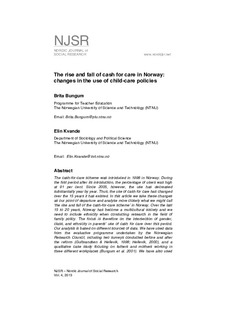| dc.contributor.author | Bungum, Brita | |
| dc.contributor.author | Kvande, Elin | |
| dc.date.accessioned | 2018-01-02T13:32:30Z | |
| dc.date.available | 2018-01-02T13:32:30Z | |
| dc.date.created | 2013-03-05T13:26:09Z | |
| dc.date.issued | 2013 | |
| dc.identifier.citation | Nordic Journal of Social Research. 2013, 4 31-54. | nb_NO |
| dc.identifier.issn | 1892-2783 | |
| dc.identifier.uri | http://hdl.handle.net/11250/2474078 | |
| dc.description.abstract | The cash-for-care scheme was introduced in 1998 in Norway. During the first period after its introduction, the percentage of users was high at 91 per cent. Since 2005, however, the use has decreased substantially year by year. Thus, the use of cash for care has changed over the 15 years it has existed. In this article we take these changes as our point of departure and analyse more closely what we might call ‘the rise and fall of the cash-for-care scheme’ in Norway. Over the last 15 to 20 years, Norway has become a multicultural society and we need to include ethnicity when conducting research in the field of family policy. The focus is therefore on the intersection of gender, class, and ethnicity in parents’ use of cash for care over this period. Our analysis is based on different sources of data. We have used data from the evaluative programme undertaken by the Norwegian Research Council, including two surveys conducted before and after the reform (Gulbrandsen & Hellevik, 1998; Hellevik, 2000), and a qualitative case study focusing on fathers and mothers working in three different workplaces (Bungum et al. 2001). We have also used three other statistical studies which were carried out at two different points in time (Pettersen, 2003; Hirch, 2010; Bakken & Myklebø, 2010). Our findings indicate that cash for care is a scheme that mainly encourages mothers who have low income and a low educational level and who are to a large degree from immigrant backgrounds to remain outside the labour market. By distinguishing between three phases, we have aimed to illustrate how the intersection of gender, class, and ethnicity enters in different ways into both the discourse and the practices connected to the cash-for-care scheme since it was introduced in 1998. | nb_NO |
| dc.language.iso | eng | nb_NO |
| dc.publisher | Høgskolen i Oslo og Akershus | nb_NO |
| dc.relation.uri | https://boap.uib.no/index.php/njsr/article/viewFile/241/389 | |
| dc.rights | Navngivelse 4.0 Internasjonal | * |
| dc.rights.uri | http://creativecommons.org/licenses/by/4.0/deed.no | * |
| dc.title | The rise and fall of ‘cash for care’ in Norway:changes in the use of child-care policies | nb_NO |
| dc.type | Journal article | nb_NO |
| dc.type | Peer reviewed | nb_NO |
| dc.description.version | publishedVersion | nb_NO |
| dc.source.pagenumber | 31-54 | nb_NO |
| dc.source.volume | 4 | nb_NO |
| dc.source.journal | Nordic Journal of Social Research | nb_NO |
| dc.identifier.doi | 10.7577/njsr.2065 | |
| dc.identifier.cristin | 1017092 | |
| dc.relation.project | Norges forskningsråd: 219116 | nb_NO |
| dc.description.localcode | Copyright (c) 2013 Brita Bungum, Elin Kvande. This work is licensed under a Creative Commons Attribution 4.0 International License. | nb_NO |
| cristin.unitcode | 194,67,80,0 | |
| cristin.unitcode | 194,67,25,0 | |
| cristin.unitname | Institutt for lærerutdanning | |
| cristin.unitname | Institutt for sosiologi og statsvitenskap | |
| cristin.ispublished | true | |
| cristin.fulltext | original | |
| cristin.qualitycode | 1 | |

